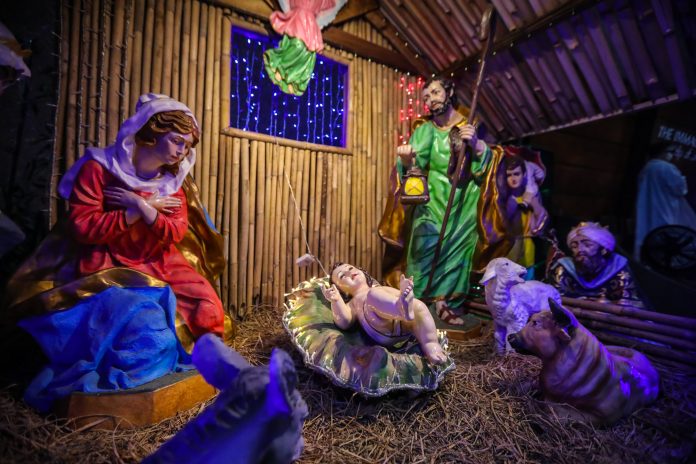Bishops might wish to survey how many families still display the belen (crèche). The results can be dispiriting. Or maybe they themselves pass over home “reenactments” of the Nativity.
In my youth in the ‘60s dusting off the belen signaled Christmas time. My earliest memories are of a colorful cardboard cutout of the characters and scenes set at the sala.
On the right side of the manger were the Three Kings bearing gifts of gold, myrrh, and frankincense plus the camels they rode on to Bethlehem. On the left were shepherds, one of them a lad with a lamb offering on his shoulders.
At the center were Mother Mary on her knees cradling the Infant Jesus. St. Joseph towered over them, a staff in hand.
Corralled behind were a donkey, cow, and goat. Completing the tableau was an angel on the roof unfurling a banderole that proclaimed “Gloria in Excelsis Deo”.
That classic belen adorned our living room table with many Yuletides. The scotch tape held the elements intact. A replica enlivened our classroom.
Mom finally replaced the torn model with a new set of ceramic figurines. We laid them out extra carefully, lest they chip. We strewed hay around the table for special effects in “staging” the Nativity.
We placed the Magi and shepherds at opposite far ends of the table, moving them a bit nightly towards Mary and Joseph at the center. A small parol hanging from the ceiling served as the Star of Bethlehem.
My sister added Baby Jesus only on Christmas Day, insisting that that’s how it happened. Oo nga naman. We learned that our cousins and classmates did the same.
After Noche Buena’s late dinner, we gathered round the Belen to sing “Silent Night”, then opened our presents.
Videographers, scholars, and tourists flock to the few towns that still present the Panunuluyan. The interactive Nativity street play is a grand event.
Commencing and ending at the church courtyard, the dialogues in verse, choir singing, and band playing can last two hours. I was fortunate to witness one in Pakil, Laguna, in the late ‘70s.
A comite de festejos picked the director who cast the Three Kings, pastores, St. Joseph, Angel Gabriel, Elizabeth, and Herod. Special care was taken to choose who was to play the starring role of Mama Mary.
The Panunuluyan was staged on Christmas Eve. Scene 1 was Angel Gabriel announcing to Mary her impending motherhood of the King of Kings, followed by the visitación to cousin Elizabeth.
The next scene unfolded at the town plaza, with Mary riding a mule led by Joseph. Mary had a pillow under her costume, ready to give birth. They stopped by three houses with balconies, pleading in rhyme for a room for the night. From each balcony, a cantora rejected them in rhyme.
The couple proceeded to the manger on the church patio. The Holy Infant was born as the choir of angels sang. The pastores joined in.
On the sidelights, King Herod interrogated the Three Wise Men. The latter then walked on to pay homage to Baby Jesus. Leading them was a parade of the best parol in town.
The audience was silent with rapt. In the peripheries vendors sold inihaw na mais, puto, bibingka. It was late in the night and the youngsters were yawning.
At that point, an angry Herod ordered the slaying of all newborns. Whereupon his soldiers went after the sleepy kids. Shrieking, the latter jumped up their fathers’ shoulders or under their mothers’ saya.
An avenging angel cast a spell on Herod, who turned mad and went around town laughing wildly – and grabbing free drinks at carinderias. At midnight everybody joyfully welcomed Christmas.
The Panunuluyan was also staged in Gapan, Nueva Ecija; Malolos, Bulacan; and Gasan, Marinduque. Other names for it are Kapanganakan and Panawagan. Bicolanos call it Kagharong or Panharong-harong (going from house to house).
Cavite’s version is called Maytines, from the early-morning matin prayers.
Jarius Bondoc is an award-winning Filipino journalist and author based in Manila. He writes opinion pieces for The Philippine Star and Pilipino Star Ngayon and hosts a radio program on DWIZ 882 every Saturday. Catch Sapol radio show, Saturdays, 8 to 10 a.m., DWIZ (882-AM).
The views expressed in this article are the opinions of the author and do not necessarily reflect the editorial stance of LiCAS News.









